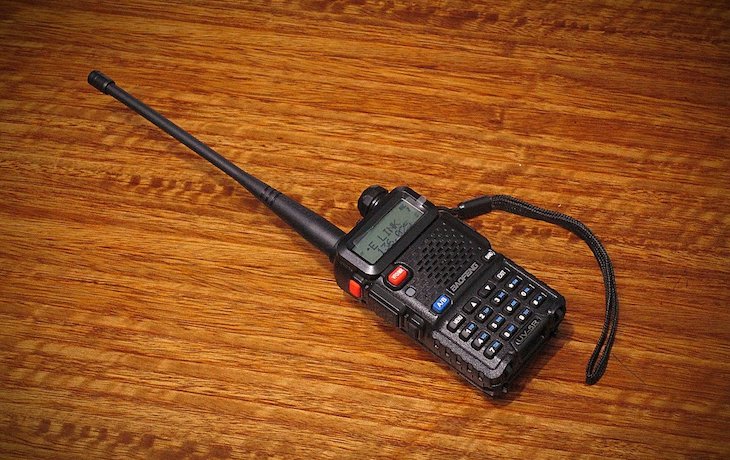But there are times when you may need to program a frequency into your radio while in the field, so manual programming is a valuable skill. Unfortunately, the included manual isn’t very helpful. There’s an alternative available from the Chinese Radio Documentation Project, but it hasn’t been updated in nearly a decade. Operator KC7OM has created a printable reference card that you can print, cut out, and place between the battery and radio so it’s always accessible.
More: How to program a ham radio with free CHIRP software
These instructions are tailored for the BaoFeng UV-5R, but should work for most of its derivatives like the BaoFeng BF-F8HP. If you’re ready to upgrade to an easier radio to program, check out best handheld ham radios.
New to ham radio? Confused by the terminology? Check out our beginner’s guide to ham radio.
What is meant by “programming”
Radio conversations happen on a frequency, like 146.52. You’re likely to use several frequencies in radio communications, so instead of having to memorize a whole bunch of frequencies, you can program them into your radio as channels. So if you program 146.52 into channel 1, you just have to remember to tune into channel 1 instead of the frequency. You can also scroll through your list of channels instead of keying them in every time.
When communicating over a single frequency, that’s called simplex. For example, if you tune into 146.52 and someone else is on that frequency that you talk to, that’s simplex.
The process of adding frequencies to channels is called programming. This becomes more important when you use repeaters, which are automated stations that listen for transmissions on one frequency and “repeat” them over another frequency. Repeaters have other complications as well. Many require the radio to send a special tone, called a CTCSS tone or a DCS tone, before the repeater will repeat transmission from that radio. Unless you program the correct tone into the channel, transmission to that repeater will be fruitless.
Since repeaters use two frequencies for communications, that’s called duplex, as opposed to simplex.
There are two useful websites for finding frequencies to program into your radio: RepeaterBook, which tracks ham radio repeaters, and RadioReference, which lists first responder frequencies. CHIRP can import frequencies from these databases automatically, which is faster than manual programming and minimizes errors.
Programming simplex channels into a BaoFeng
Manually programming simplex frequencies is simpler than programming repeaters, so it’s a good place to start.
First, you need to be in frequency mode instead of channel mode. In frequency mode, you dial in frequencies directly, while in channel mode you move between pre-programmed channels.
Turn on your BaoFeng and look at the screen. If you see channel numbers at the right of the screen, you’re in channel mode. To switch between the modes, press VFO/MR.
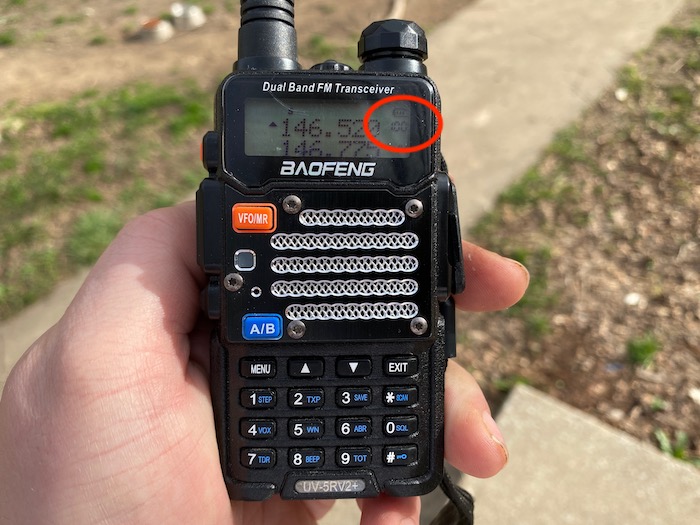
You’ve probably noticed two sets of frequencies on the screen, one on top and one on the bottom. The BaoFeng lets you quickly switch between two frequencies by pressing the A/B button. To program a frequency, you need to be on the top frequency, which is indicated by a small arrow on the left.
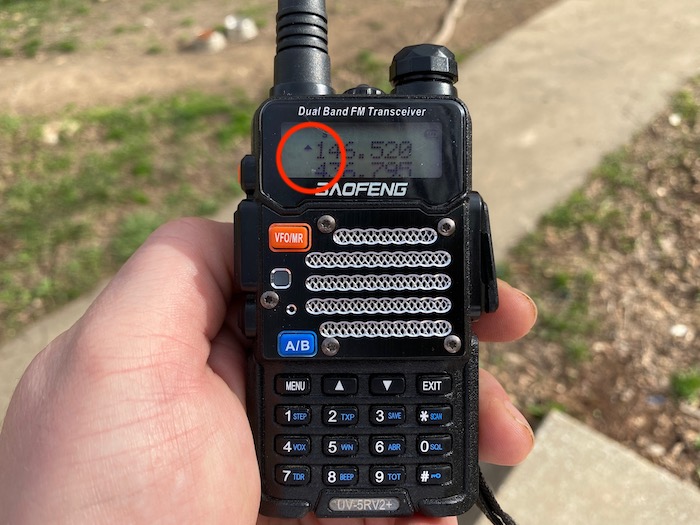
Once you’re in frequency mode and you’re on the top frequency, enter the frequency you want with the keypad, like 146.52. The BaoFeng takes three digits after the decimal point, so to enter a frequency you need to add zeroes to the end, like so: 146.520. There’s no need to enter the decimal point, so just type 146520.
Once the top frequency is the one you want to program, press Menu. You can scroll to the MEM-CH menu item, but it’s easier to type 27. MEM-CH is the setting that programs channels into memory. Once on MEM-CH, press Menu to adjust that setting. You know you’ve done this successfully when the small arrow on the left moves from MEM-CH to CH-000, which is the default channel.
Tip: You can press Exit at any time to exit the settings menu, either before or after saving changes.
To enter a channel, either type it in on the keyboard or use the arrow keys to scroll to it. Once you have the channel you want to program the frequency into, press Menu followed by Exit.
Once back on the main menu, press VFO/MR to switch to channel mode. Either scroll to the programmed channel with the arrows or enter it on the keypad to confirm that the channel was programmed successfully.
Programming repeaters into a BaoFeng
Once you have the basics of programming channels, you’re ready to manually add repeaters. For repeaters, you need four pieces of information: the main frequency, the offset, offset direction, and the tone. (On RepeaterBook, tone is listed as tone in / tone out, but they should be the same for FM stations compatible with the BaoFeng.)
The main frequency is the one the repeater transmits on, which is the frequency you listen to. The offset is the frequency that the repeater listens on, which is what you transmit to. Offsets are expressed in positive or negative numbers. So if the repeater frequency is 146.67 MHz and the offset is -0.6 MHz, you transmit on 146.07. If the offset was +0.6, you would instead transmit on 147.27.
As an example, let’s use W4CAT, which is a repeater around Nashville:
- Frequency: 146.955
- Offset: -0.6 MHz
- CTCSS: 114.8
Repeat the first couple of steps from above: make sure you’re on the top frequency in VFO mode and enter the repeater frequency.
Set the offset direction:
- Press Menu
- Type 25 or scroll to SFT-D
- Press Menu
- Use the arrows to set +, -, or off
- Press Menu
Then set the offset frequency:
- If you’re in the menu, press 26 or scroll to OFFSET
- Press Menu
- Enter the offset (for 0.6, type 000600)
- Press Menu
Finally, the tone:
- If you’re in the menu, press 13 or scroll to T-CTCS (short for transmit CTCSS)
- Press Menu
- Use the keypad to enter the tone frequency
- Press Menu
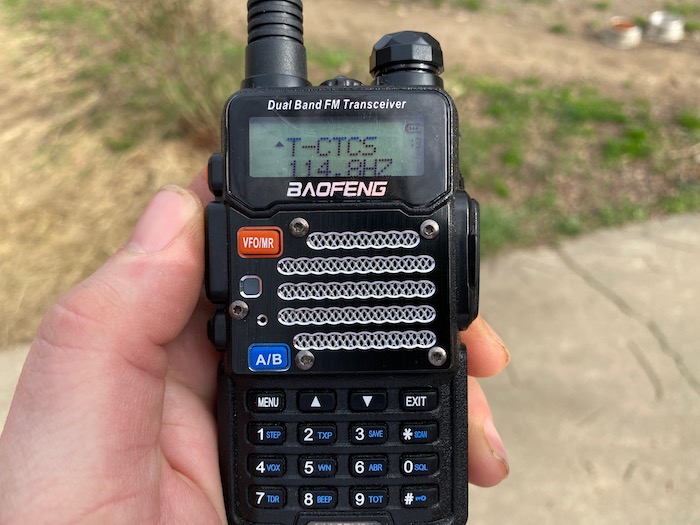
Once everything is set correctly, save the frequency to a channel just as you would for simplex. The offset direction, offset frequency, and CTCSS tone settings should save to that channel.
It’s easy to see if everything was saved correctly. Scroll to the repeater’s channel. You should see +- appear at the top of the screen to indicate an offset. When you press the PTT button on the side to transmit, you should see two things: CT appears on the left, indicating a CTCSS tone being transmitted, and the frequency dropping or increasing to the offset. For instance, for 146.955 and an offset of -0.6 MHz, the frequency changes to 146.355.
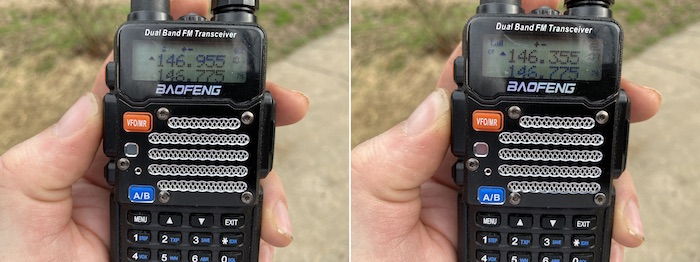
To set a DCS tone, you follow the same procedure, except you set menu item 12, T-DCS, instead.
How to delete a channel
It’s much easier to delete a channel than add one:
- Press Menu
- Enter 28 or scroll to DEL-CH
- Press Menu
- Scroll to or enter the channel to delete
- Press Menu
Be careful here, because there is no confirmation prompt. If you get into the menu and change your mind, press Exit before step 5.
